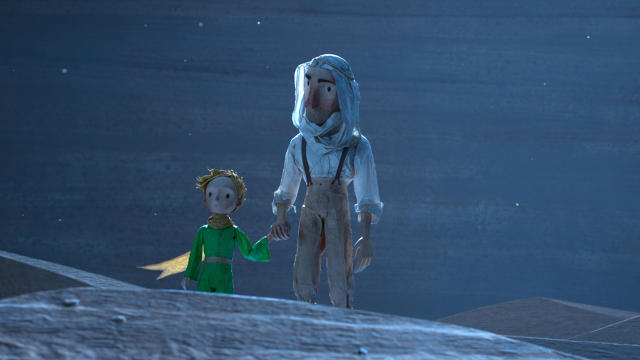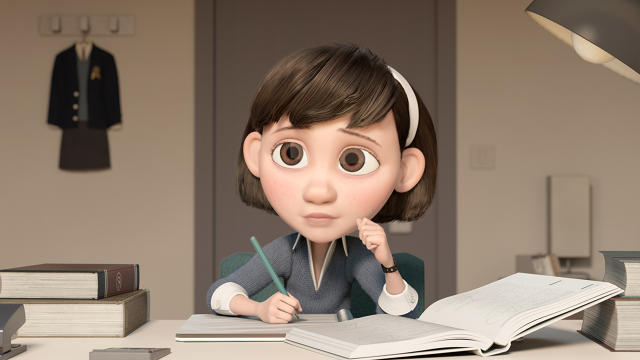Director Mark Osborne Explains Why His Version Of “The Little Prince” Shouldn’t Exist
Earlier this year, director Mark Osborne (Kung Fu Panda, The SpongeBob SquarePants Movie) was on a plane coming from Paris in spirits higher than the altitude.
His film that had been six years in the making and the paradigm of a passion project won the César Award (aka, the French Oscar) for best animated feature—a definitive stamp of approval from French critics and audiences on Osborne’s adaptation of one of their country’s most beloved cultural properties, Antoine de Saint-Exupéry’s 1942 novella Le Petit Prince (The Little Prince). It was validation for Osborne’s career as a director but also a personal triumph with so much of his life woven into the film: his son Riley voiced the character of the Little Prince, his wife gifted him a copy of The Little Prince 25 years ago when they were dating, the story line he created that runs parallel to the book allowed him to work out his own issues of growing up with divorced parents.
At the time of César Awards, The Little Prince had raked in nearly $100 million in box offices overseas and had a 95% freshness rating on Rotten Tomatoes. Suffice it to say, Osborne’s pride in his directorial feat was hard-earned, which makes what happened shortly after he got off the plane that much more bizarre.
Paramount Pictures was handling the U.S. release of The Little Prince but pulled out the week it was scheduled to hit theaters stateside.
“To be honest, I’m still licking my wounds,” Osborne says. “Paramount owned the rights because of the movie they made in the ’70s. So they had the rights to release it, but they never had the investment. There’s more to the story that I can’t get into. All I can say is it has been an incredibly unconventional project from beginning to end.”
Ever the angel of acquisitions, Netflix quickly swooped in to give The Little Prince a home both on its streaming platform and in theaters.
“This movie is on so many levels miraculous—it shouldn’t exist,” Osborne says. The Little Prince is essentially a gigantic, international independent film. Osborne and his patchwork team of producers managed to secure funding from a host of countries, none of which included the U.S. Osborne’s audacious plan to blend CGI animation with stop-motion was foreign territory to his band of animators. The source material itself is basically an abstract poem that doesn’t provide much of a base for a narrative film to successfully match the book’s artistry in illustration and story—cue the 1974 musical adaptation starring Gene Wilder.
“The book is full of unexpected things, so the movie had to be,” Osborne says. And that unexpectedness is largely why Osborne refused to direct the film at first.
When producers first approached Osborne with the idea of adapting The Little Prince into a CGI movie, Osborne balked. He was well aware of previous attempts at translating the book into film and felt like none of it worked. But a quote he’s held onto from the book eventually put everything into perspective: “It is only with the heart that one can see rightly; what is essential is invisible to the eye.”

“Most of the reasons why I said no are the reasons why I said yes,” Osborne says. “I couldn’t stop thinking about what the book meant to me. I woke up thinking about that quote and the amazing opportunity to have that as the core idea of the movie.”
Inspired by non-traditional adaptations like Spike Jonze and Charlie Kaufman’s 2002 film Adaptation based on Susan Orlean’s book The Orchid Thief, Osborne knew there was a way to use The Little Prince as a framework to build the larger structure of another story.
Exupéry’s novella is narrated by a pilot who crashes in the desert and befriends a curious boy from asteroid B-612 who is desperately looking for a way back home after falling to Earth. Osborne’s film centers on a little girl whose summer vacation is subsumed with academic preparations laid out by her overworked helicopter mom. The Little Girl’s life has been meticulously planned—play dates and general fun have been trimmed for maximum productivity. When the Little Girl befriends the Aviator, the quirky old man living next door, he envelops her in the world of the Little Prince and she’s reminded of what it’s like to be a kid. However, much like Exupéry’s book in which its simplicity belies its philosophical depth and sharp social criticisms, Osborne’s film pulls zero emotional punches with the themes of loss and grief. Part of highlighting that concept for Osborne meant displacing one of his central characters.
“Animated movies always have an orphan or a single parent, and I was determined to have both the mom and the dad, but the story didn’t work until we took the dad and put him somewhere else,” Osborne says. “It wasn’t working with two parents because [the Little Girl] had too much support—we weren’t able to highlight the theme of abandonment.”

The Little Girl’s father never appears in the film—he’s represented from a distance through the snow globes he sends his daughter from his business trips.
“The snow globes were the ‘aha’ moment that made it work because we were talking about eliminating [the dad] but it was crazy because he couldn’t be dead,” Osborne says. “If he were dead then the whole movie is about her dealing with his death and we wanted it to be about her dealing with the inevitable death of the Aviator.”
As a child of divorce, Osborne says he unconsciously factored in elements of his own childhood.
“[The rewrite] made me dig deeper emotionally into the stuff that I needed to work out about my own issues of abandonment. It was like, ‘this is what [the movie] is supposed to be’—not only to help the book, but to help me get to a place where I am doing something more personal,” Osborne says. “In a weird way, it brought us much closer to the book. Movies work the best when they can be universal [and] very specific.”

That dichotomy is precisely why The Little Prince is one of the top best-selling books in the world, and why Osborne had to be very careful in how he pitched his version to everyone involved, particularly Exupéry’s estate.
Skepticism of Osborne’s bold ambitions were doused by the persuasiveness of his “magical suitcase” containing an art book and handmade models of characters to make Osborne’s story and vision of blending CGI and stop-motion less abstract. By his count, Osborne claims to have pitched The Little Prince close to 400 times.
“I hadn’t quite learned the art of pitching before this project,” Osborne admits. “Especially in animation, you’re constantly informing large groups of people about what you’re trying to accomplish, but to have a very focused and very visual [pitch] was crucial.”
All that pitching also allowed Osborne to workshop his film, adding and whittling down ideas to create a more cohesive story through a process he likened to doing improv.

“But the best thing was it got people so locked into it,” Osborne says. “Animation takes years and hundreds of people, and if anybody is not completely locked in and focused on what you’re trying to do, the movie can go off the rails. I never wanted to have any artist working on the movie to be in a position where they’re just punching the clock—I want them to be thinking and aware of what this really means.”
So what does The Little Prince mean to Osborne after his six-year odyssey?
“I was very thrilled at the prospect of being able to build something, but I was terrified the entire time. I ultimately went forward and said I’d rather get in trouble for swinging for the fences and doing something that tries to be as big and as iconic as the book has become in our world than get in trouble for not doing enough,” Osborne says. “There’s been so much hell and hardship on this movie, but I think the book truly is magic. So many people were so passionate and engaged, and it’s the tribute to the book that is the thing that made [the movie] exist. There’s so much magic that happened that I’m in awe of.”
The Little Prince will premiere on Netflix and in theaters Friday, August 5.
Fast Company , Read Full Story
(65)













